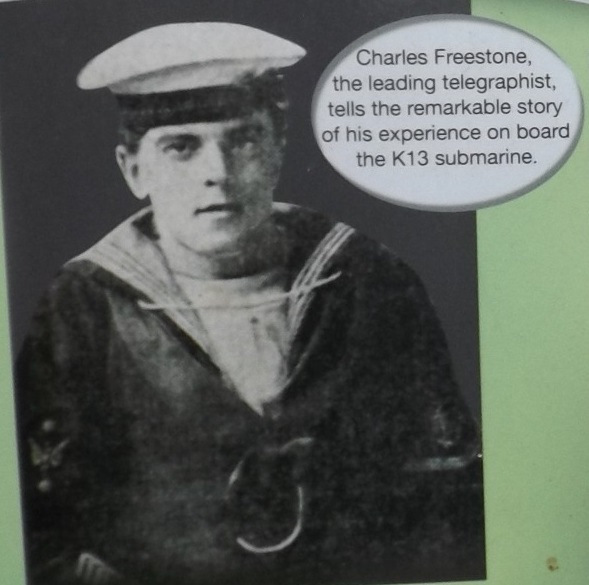The large white-painted "K13" can easily catch your eye, if you aren't concentrating too much on the traffic of Pennant Hills Road. This Memorial came about from the generosity of Charles Freestone (1896-1956?), the surviving leading telegrapher of the K13 submarine, that dived off of Scotland in its testing phase, but had some hatches partially open, and sank in 1917.
Charles later emigrated to Sydney Australia, and part of estate was used by his widow to create this Memorial at Carlingford, not just for the K13 tragedy, but for all submarines that have been lost. The Wikipedia article gives a good account of the Report on the original tragedy.
From the 'Submariners - Australia' website, is the following excerpt:
"Charles Freestone was born in Chelmsford, Essex in 1896. He volunteered for submarine service in the Royal Navy during the First World War and was a Leading Telegraphist in K13. Subsequently he was transferred at his own request to HMA Submarine J3 and, later J4 and at the end of his service in the RAN he remained in Australia.
"Always mindful of his old comrades of the submarine service, the late Charles Freestone set aside part of his subdivision in Pennant hills Road, Carlingford in 1956 to be named the “K13 Memorial Park”.
"Mrs M. F. Freestone the widow of Charles A. Freestone. a survivor of HM Submarine K13 fulfilled her late husbands wish for a memorial in 1961."
Minutes: 27thSeptember, 2017
MEN ALIVE: 57 Hours in a Sunken Submarine
Amidst World War 1 there was a rush to make submarines larger, faster and more powerful. The British Navy developed new 'K' class submarines, experimenting with a combination of oil heated boilers and electronic motors to increase speed.

Cropped from sign
[Charles Freestone, the leading telegraphist, tells the remarkable story of his experience on board the K13 submarine.]
Just after lunch on 29 January 1917 the newly built K13 submarine was undergoing a final dive trial off the west coast of Gareloch, Scotland.
An air ventilator was left open by accident and the boiler room was flooded as hundreds of tonnes of water gushed in. To prevent the complete flooding of the boat, bulkhead doors were closed. Tragically 31 men in the engine room drowned.
The K13 and its surviving crew became trapped under 30 metres of water without a working engine
DESPERATE POSITION
Chlorine gas leaked from the batteries polluting the air. The men were running out of vital clean air, had no food and very limited water on board.
A note was written and sent as Morse Code by tapping a spanner on the metal hull to get the message to the divers who were swimming in the ocean outside the submarine.
A BOLD PLAN
Commander Goodhart and Lieutenant Commander Herbert entered the conning tower in a bid to escape through its hatch. The pressure was too great and Goodhart sacrificed himself so that Herbert could reach the surface to help the rescue party.
A day later a seven inch (18 cm) tube was fitted to the submarine and life supporting air flowed to the men of the K13. Using the tube the crew could also communicate with the rescue party on the surface.
A small bottle of brandy was passed down the tube.
'Each man was given a teaspoon to drink. A second larger bottle became jammed and the tube had to be disconnected. Again we lost touch with the outside world'. Charles Freestone
DIVERS AT WORK
Meanwhile the divers were working continuously in the bed of mud on the bottom of the loch to lift the nose of the heavy submarine.
FREEDOM AT LAST
Fifty seven hours later the submarine began to rise. On the surface a blowtorch was used to cut a hole in the hull. Gasping for fresh air the exhausted crew scrambled outside, relieved but hungry.
TRIAL AND ERROR
The K13 was taken to the ship yard and repaired. Several changes were made and the submarine was renamed the K22.
The Navy found that it took too long to switch from oil heated boilers and back to using deisel (sic) engines on the surface and electric motors when submerged.
SACRIFICE
They have no grave but the cruel sea,
No flowers lay at their head.
A rusting hulk is the their tombstone,
Afast on the ocean bed.
They shall grow not old,
As we that are left grow old.
Age shall not weary them
Nor the years condemn
At the going down of the sun and in
the morning we will remember them.
LEST WE FORGET
Address: 304 Pennant Hills Road, Carlingford, NSW, 2118
Australian War Memorials Register website: K13 Memorial Park
Visited: 1249, Sunday, 4 June, 2017 [A memorial that I have noted for decades, as I have been driven, or drove myself past it.]